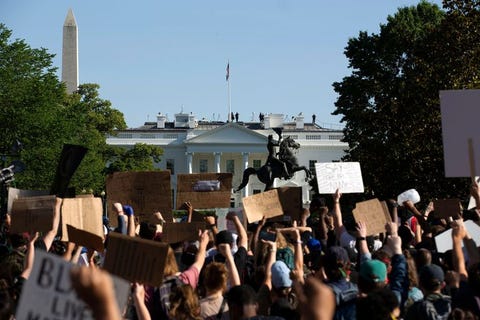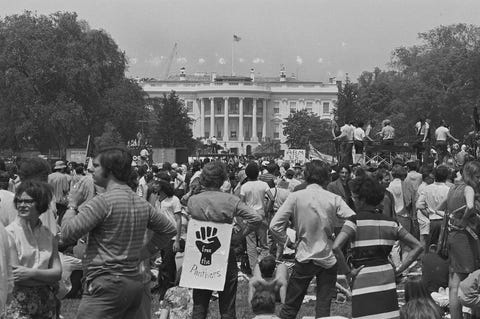Christmas Photos of White House Outside Decorated

Win McNamee Getty Images
Protests against police brutality and white supremacy erupted around the country in the wake of George Floyd's death in Minneapolis—and it's no surprise that demonstrators soon arrived at the White House. The actions of police to forcibly disperse protestors at 1600 Pennsylvania Avenue on June 1 were shocking and widely condemned, but peaceful demonstrations have continued to assemble in the days since. They join a long history of protest movements that have traveled to Washington, D.C.—and specifically to the White House—to advocate for their cause. From the Women's Suffrage Movement in the early 20th century to the famed March on Washington to today's Black Lives Matter protests, Americans have long exercised their right to free speech and assembly on the President's doorstep. Here, we've compiled a few iconic photographs of protests at the White House, along with some of the history behind these landmark movements.

JOSE LUIS MAGANA Getty Images
1 of 22
2020 — Black Lives Matter
After the death of George Floyd in Minneapolis at the hands of a white police officer, protests erupted around the country against police brutality and white supremacy. Here, protesters gathered at the White House to show their support for the Black Lives Matter movement.

JOSE LUIS MAGANA Getty Images
2 of 22
June 1, 2020
Earlier this week, peaceful protestors, journalists, and clergy were forcibly dispersed by police using flash grenades and chemical spray so that President Donald Trump could walk across Lafayette Square, the park in front of the White House, for a photo opportunity in front of St. John's Episcopal Church (seen here). The images shocked a nation. "When the history of the Trump presidency is written, the clash at Lafayette Square may be remembered as one of its defining moments," wrote the New York Times.

ERIC BARADAT Getty Images
3 of 22
2019 — Climate Strike
Led by youth activist Greta Thunberg, students, young people, and their families protested for greater environmental reform and for government officials to further protect out planet against climate change. Here, teenagers hold up a banner stating, "We Don't Want to Die" in front of the White House.

SAUL LOEB Getty Images
4 of 22
2018 — March for Our Lives
Thousands of American students participated in a sit in for 17 minutes in honor of the 17 students killed at the Stoneman Douglas High School shooting in Parkland, Florida. This was part of the student-led protest, March for Our Lives, which advocated for gun control in the wake of countless school shootings across the nation.

ANDREW CABALLERO-REYNOLDS Getty Images
5 of 22
2017 — The Women's March
The day after Trump's inauguration, approximately half a million people gathered in Washington, D.C. to advocate for human rights legislation, and to express their frustration with the newly elected President Trump.

Alex Wong Getty Images
6 of 22
2014 — Black Lives Matter
After a grand jury decided that officer Darren Wilson would not be charged in the shooting of Michael Brown in Ferguson, Missouri, protestors headed to Washington to rally around the Black Lives Matter movement and advocate against police brutality.

AFP Getty Images
7 of 22
2009 — National Equality March
Members of the LGBTQ+ community and allies marched through Washington, D.C., asking President Obama to repeal "Don't Ask Don't Tell," a ban on gays and lesbians in the military, and to advocate for equal rights. Many protesters chose to demonstrate after being outraged by California's Proposition 8, which overturned marriage equality in the state.

Win McNamee Getty Images
8 of 22
2005 — Protests Against War in Iraq
In 2005, demonstrators protested against the Iraq War outside of the White House. The activists were led by Cindy Sheehan, the mother of a soldier killed in Iraq, and called for an end to the war, which, at that point, was going on its second year.

ANDREW COUNCILL Getty Images
9 of 22
2005 — Protests Against War in Iraq
Protestors made a variety of anti-war signs, while demonstrating for the end of the Iraq War.

TIM SLOAN Getty Images
10 of 22
1999 — Protests Against Bombings in Yugoslavia
Serbian protestors marched in front of the White House to call for the end of NATO-led bombings on Yugoslavia during the Kosovo War. The air strikes continued until Yugoslav armed forces withdrew from Kosovo, and the UN established the United Nations Interim Administration Mission in Kosovo.

Bettmann Getty Images
11 of 22
1987 — March on Washington for Lesbian and Gay Rights
In addition to advocating for LGBTQ+ rights broadly, the Second National March on Washington for Lesbian and Gay Rights also drew attention to the AIDS pandemic, asking for more research funding to combat the disease and acknowledgement from President Reagan.

Bettmann Getty Images
12 of 22
1977 — Anti-ERA Protests
Republican activist Phyllis Schlafly protested in front of the White House in 1977. Schlafly, the leader of STOP ERA, was fighting against the consideration of the Equal Rights Amendment, a constitutional amendment that would grant both sexes equality under the law. The amendment was not passed.

Bettmann Getty Images
13 of 22
1976 — Protests in Support of the ERA
Feminists also protested in Washington, D.C., in favor of the Equal Rights Amendment. Here, a group of activists carried a banner past the White House advocating the amendment's passage. Leaders of the pro-ERA movement included Gloria Steinem, Shirley Chisholm, and Betty Friedan.

MPI Getty Images
14 of 22
1974 — Impeach Nixon Protest
After the Watergate scandal, where the Nixon administration covered up a failed break-in to the Democratic National Committee Headquarters, protestors advocated Nixon's impeachment and removal in front of the White House. Nixon resigned rather than await impeachment.

David Fenton Getty Images
15 of 22
1970 — Protests Against the Vietnam War
Demonstrators gathered in front of the White House to condemn American involvement in Vietnam. This specific protest came after the Kent State shootings and the Nixon administration's Cambodian incursion.

National Archives Getty Images
16 of 22
1965 — Civil Rights Protests in Solidarity with Selma
After the violence that became known as "Bloody Sunday," when state troopers attacked unarmed marchers traveling from Selma to Montgomery, Alabama, protestors assembled in front of the White House in solidarity with the Alabama marchers. The activists questioned why President Johnson had not yet delivered the voting rights bill to Congress or sent federal troops to Alabama to protect protestors.

Francis Miller Getty Images
17 of 22
1965 — Civil Rights Protests
Protestors linked arms in front of the White House at a civil rights rally.

Bettmann Getty Images
18 of 22
Late 1940s — Anti-Lynching Protests
In 1946, four young African Americans were murdered by a mob of angry white men in what is now known as the Moore's Ford Lynchings. The lynching caused widespread protests including many in Washington, D.C. Here, protestors called for President Truman to put an end to lynchings.

Bettmann Getty Images
19 of 22
Late 1940s — Anti-Lynching Protests
Women peacefully protested against lynching in front of the White House. Their signs stated "Stop Lynching Let Real Democracy Prevail" and "Lynching is Disgraceful Let's Stop It."

Getty Images
20 of 22
1933 — Protesting the Scottsboro Boys' Trial
In the early 1930s, nine young African American men (later known as the Scottsboro boys) were wrongly accused and convicted of the rape of two white women. Eight of the nine were sentenced to death. However, with an all-white jury and rampant racism in the courtroom and the country, the case prompted an outcry for civil right's legislation and a fair trial. In 1933, thousands of people took to Washington to protest the situation and demand the release of the defendants.

Bettmann Getty Images
21 of 22
1910s — Women's Suffrage Protests
A woman identified as Mrs. William L. Colt picketed the White House in a series of protests for women's suffrage. In the early 1910s, protests organized by Alice Paul, Lucy Burns, and the National American Woman Suffrage Association (NAWSA) erupted in Washington the day before President Woodrow Wilson's inauguration. The group's message was to "march in a spirit of protest against the present political organization of society, from which women are excluded."

Stock Montage Getty Images
22 of 22
1910s — Women's Suffrage Protests
A protesting suffragette held up a sign asking, "How long must women wait for liberty?"
Christmas Photos of White House Outside Decorated
Source: https://www.townandcountrymag.com/society/politics/g32746486/white-house-protests-history-photos/